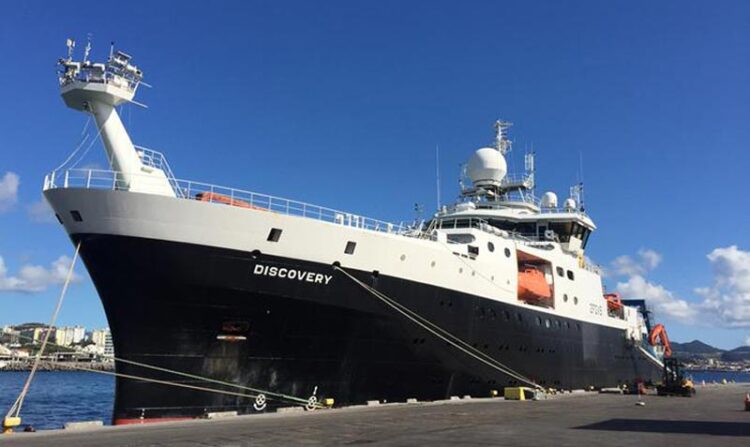Ocean waves propel PFAS back to land

Royal Research Ship (RSS) Discovery stopped at Azores, Portugal, for supplies during the 29th Atlantic Meridional Transect (AMT29). The cruise departed from Southampton in the UK on October 13th 2019 and arrived at Punta Arenas in Chile on November 26th 2019, covering a meridional transect from approximately 50°N to 50°S.
Credit: Bo Sha, Department of Enviromental Science, Stockholm University
A new study by researchers at the Department of Environmental Science, Stockholm University, published in Science Advances, reveals that PFAS re-emit into the air from crashing ocean waves at levels comparable to or greater than other sources, establishing a cyclical transport process for these “forever chemicals” between land and sea.
“The common belief is that per- and polyfluoroalkyl substances, PFAS, drain from the land into the oceans where they stay to be diluted into the deep oceans over the timescale of decades,” said Ian Cousins, Professor at the Department of Environmental Science and co-author of the study. “But we’ve now demonstrated in multiple studies that there’s a boomerang effect, and some of the toxic PFAS are re-emitted to air, transported long distances and then deposited back onto land.”
Field experiments across the Atlantic Ocean conducted by co-authors Bo Sha, Post-doc at the Department of Environmental Science and Jana Johansson, former Researcher at the Department of Environmental Science, currently at Linköping University, showed PFAS concentrations in air particles surpassing seawater concentrations by over 100,000 times. Subsequent global modeling estimated the re-emission, atmospheric transport, and deposition of PFAS to land.
“Jana (Johansson) and I worked intensively for two months on a ship conducting multiple field experiments with our custom-built sea spray simulator,” explained Bo Sha, the main author of the study. “While our results are scientifically impactful, they are disconcerting, creating a lot of interest among scientists, regulators, and the public.”
PFAS impacting health in coastal regions
PFAS, characterized by their extreme persistence leading to their colloquial designation as “forever chemicals, ”are associated with a variety of serious health conditions, including cancer, fertility issues, and compromised immune system function.
“In Denmark, scientists have compiled compelling evidence indicating that the sea serves as the primary source of PFAS along their west coast,” explained Matthew Salter, Researcher at the Department of Environmental Science and co-author of the study. “This aligns with our expectations, as our study predicts that coastal regions bear the greatest impact.”
The research was funded by the Swedish Research Council, FORMAS, the INTEGRATE project, and was part of the Atlantic Meridional Transect programme funded by the UK Natural Environment Research Council.
Journal: Science Advances
DOI: 10.1126/sciadv.adl1026
Method of Research: Experimental study
Subject of Research: Not applicable
Article Title: Constraining global transport of perfluoroalkyl acids on sea spray aerosol using field measurements
Article Publication Date: 5-Apr-2024
All latest news from the category: Ecology, The Environment and Conservation
This complex theme deals primarily with interactions between organisms and the environmental factors that impact them, but to a greater extent between individual inanimate environmental factors.
innovations-report offers informative reports and articles on topics such as climate protection, landscape conservation, ecological systems, wildlife and nature parks and ecosystem efficiency and balance.
Newest articles

Innovative 3D printed scaffolds offer new hope for bone healing
Researchers at the Institute for Bioengineering of Catalonia have developed novel 3D printed PLA-CaP scaffolds that promote blood vessel formation, ensuring better healing and regeneration of bone tissue. Bone is…

The surprising role of gut infection in Alzheimer’s disease
ASU- and Banner Alzheimer’s Institute-led study implicates link between a common virus and the disease, which travels from the gut to the brain and may be a target for antiviral…

Molecular gardening: New enzymes discovered for protein modification pruning
How deubiquitinases USP53 and USP54 cleave long polyubiquitin chains and how the former is linked to liver disease in children. Deubiquitinases (DUBs) are enzymes used by cells to trim protein…



